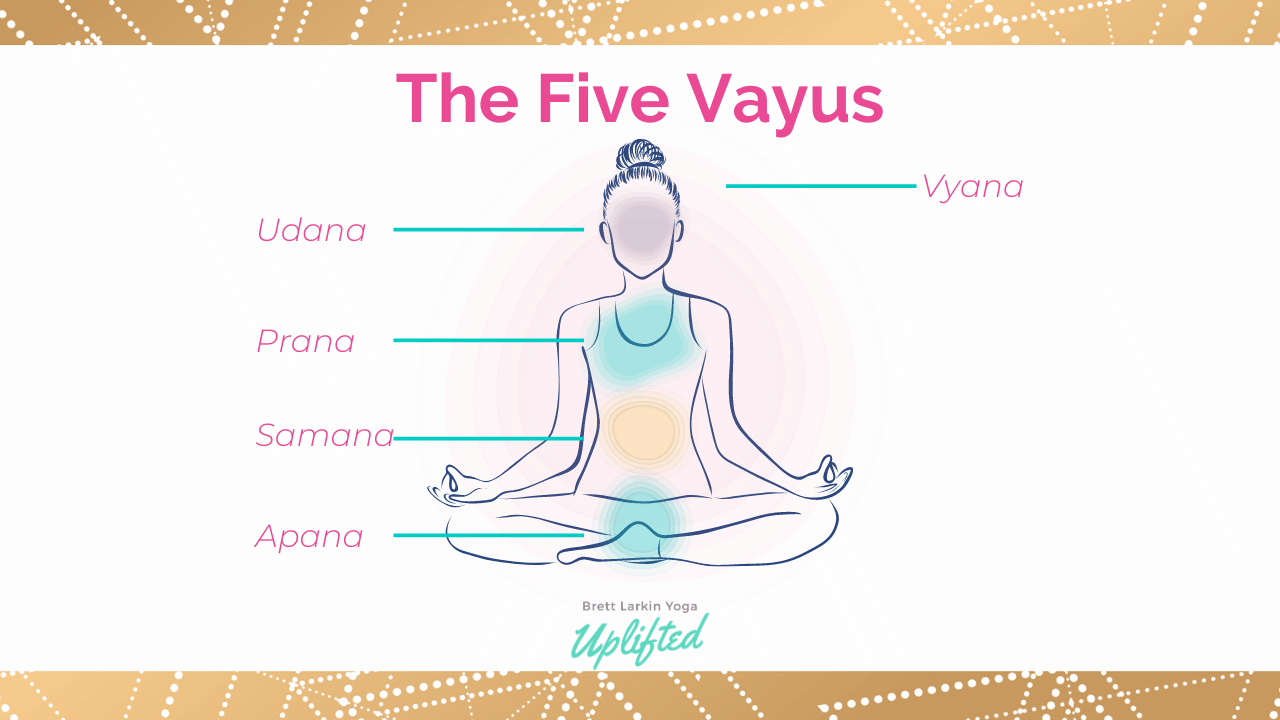If you’ve been practicing yoga for a while you’ve likely heard the word Prana before. It’s an important Sanskrit term that translates to “life force.” But just like the rest of yoga practice, this is only the tip of the iceberg.
As you dive deeper into the study of prana, you learn that it has multiple directions and qualities. Each of these forms of prana has different energies, locations & signs of imbalance. Today, we’re going to focus on what’s known as Apana Vayu – the life force that governs your physical and energetic release.
Once you become familiar with these subtle energy movements, you’re able to open up a much deeper, transformational experience within your yoga practice.
So, let’s get started learning about Apana Vayu, why it’s helpful, and how to notice signs of imbalance.
Apana Vayu: Your Energetic Release
In the Hatha Yoga Pradipika, the classic text of Hatha Yoga, there are five different movements of Prana outlined. These are called the Prana Vayus.
Apana Vayu is the movement that controls our energetic and physical waste removal. As with all five of the Prana Vayus, Apana Vayu has both physical and mental/emotional functions. It’s the energy in charge of eliminative body functions (sweat, urine, menstruation & excretion). It’s also the energy behind mental & emotional release, eliminating that which no longer serves us in the mind.

Meaning of Apana Vayu
Let’s dive into the translation of Apana Vayu a bit. Vayu is a Sanskrit word that translates to “wind.” The root syllable “va” means “that which flows.” So we can see how the Vayus are fluid, mobile energies.
Apana translates to “the air that moves away.” So though all the Vayus have inherent movement, Apana Vayu is specifically the movement of energy outwards or away from the physical body.
Apana Vayu Location in the Body
Each Vayu also has a centralized, physical location in the body, though its effects are seen throughout the entire body. Apana Vayu is most centrally located in the pelvis and the lower abdomen. Energetically, it’s associated with our Muladhara chakra or root chakra.
Movement Pattern of Apana Vayu
We often mention prana Vayu in our asana classes because it is the intake of fresh, new energy. This makes sense because we’re often energizing the body and bringing new life into us when we practice physical asana. However, Apana Vayu is just as essential in our physical practice.
While Prana Vayu draws energy in, Apana Vayu moves energy down and out. Think of it this way, prana Vayu is the inhale breath, and Apana Vayu is the exhale breath. It’s impossible to have one without the other, and they’re both essential to the other’s success in cleansing the body and keeping us healthy.
As opposing energies, there’s an inherent push/pull relationship between prana Vayu and Apana Vayu. If we can harness both energies we can find more freedom and energetic power in our practice.
Why Study Apana Vayu
What are the benefits of working with Apana Vayu? Why should we apply it to our yoga asana?
First of all, the energy of release is a powerful gateway to surrender and relaxation. If we kept ourselves in a constant state of energy intake we would quickly become depleted and burnt out. Our nervous system would weaken, and we’d quickly run out of vital energy.
Apana Vayu is necessary for the release of not only physical toxins but also destructive thoughts and negative energy. It helps maintain our body’s balance, reduces anxiety, enhances focus, and connects us to our traditional yogic practices.
So, how do we know when we should be focusing on our relationship with this vital force? When it’s imbalanced.
Common Signs of Imbalance in Apana Vayu
Our body is wise. If you’re having an imbalance of Apana Vayu and you have a strong connection to your body, you’ll be able to sense it.
When your Apana Vayu is weak you may be commonly susceptible to illness. This is due to the lack of releasing toxins from the physical body. Additional signs can manifest as excess negative energy in the mental and emotional body.
This can look like…
- Overactive fears that rule your life. This is an excess of prana in the mind that has no outlet or release.
- An overarching sense of doubt in yourself and your life. This ties into your root chakra. You’re lacking a sense of grounding in your life, so you’re unsure of where you stand.
- Issues with a physical release. This can look like constipation or irregular menses. If the body doesn’t have a regular physical release, there could be a lack of Apana energy.
- Suppressing negative emotions. This is restricting the natural flow of Apana Vayu, which will eventually cause a build up and an outburst. Release necessary emotions to stay mentally and physically well.
- Energy depletion/lethargy. This is what excess Apana Vayu looks like. If this is the case, you need to add more Prana Vayu to help balance.

How To Balance Apana Vayu
How you balance your Apana Vayu will depend on where your current relationship to the energy is. If you’re experiencing an excess of Apana Vayu (see above) you’ll want to invite practices that stimulate prana – hatha yoga, reading inspiring texts, or adding anything energizing & inspiring to your life.
Another practice for excess Apana Vayu is Mula Bandha or the root lock. This energetic lock will train the movement of Apana Vayu to work more efficiently. To practice Mula Bandha, bring a subtle lift to the pelvic floor. You should feel stabilized without clenching. Bring this practice of Mula Bandha to your asana practice and feel the flow of Apana Vayu reintegrated into the foundation of your pose.
If you’re experiencing depletion of Apana Vayu – as many of us are in this digitally-charged, modern world – you’ll want practices that help increase Apana energy. Here are some practices for those who experience a lack of Apana Vayu.
Kapalabhati Pranayama
Kapalabhati is a yogic breathing practice that facilitates an energetic release. Use these steps to practice Kapabhati.
- Bring yourself into a comfortable seated position, as you would for a meditation
- Take a few natural breaths, feeling the flow of each inhale & exhale
- To begin, create a forceful, short burst with your exhale and allow a passive inhale to result
- Continue this as quickly as is comfortable for you
- Do this for 15 pumps of breath, letting the final exhale breath be long and drawn out
- Take a few breaths to recover, and notice any changes
- Repeat this for two more sets of 15
- As you finish, let your breath return to neutral. Take a few moments to really notice the energetic change in your body
Free-Flow Journaling
Journaling is a powerful practice for both mental and emotional release. If you find yourself with an excess of cluttered thoughts this practice will help release some of that pent-up energy.
Whenever you notice yourself spiraling into thought or harboring negative emotions, grab your journal. Allow yourself to simply write whatever is on your mind. There’s no right or wrong. Feel whatever comes up, and continue until you feel ready to stop.

Apana Mudra
The Apana mudra stimulates the free flow of Apana Vayu so that it can circulate naturally out of the body. It can also be used as a general cleansing and purifying mudra.
Use these steps to practice Apana Mudra:
- Bring yourself into a comfortable seated position, as you would for a meditation
- Take a few natural breaths, feeling the flow of each inhale & exhale
- Let your hands rest on your knees, palms facing upwards
- Bring your middle and ring finger together and curl them in towards your palms, touching your thumb to your fingertips
- If you’d like, you can visualize the natural flow of energy circulating through your body
- Remain here anywhere from 5 – 30 minutes
- As you’re ready, slowly come out of your meditation and ease back into your day
Next Steps
- Check out my YouTube channel and find some yoga classes that you can try out for yourself!
- Explore my knowledge hub for How to Become a Yoga Teacher
- Attend a 200 YTT info session to see what else you’ll learn in my online teacher training.
Experience 3 Training Videos from Inside My 200-Hour Online YTT

Learn how to do 11 of the most popular yoga poses correctly. Free video + PDF download.











